
The Dumpling Diaries
I’ll never forget the day my parents took me to our local Korean joint for the first time. As a Midwestern kid, I was used to the ol’ meat-and-potatoes routine, so you can imagine my wide-eyed bewilderment when that towering plate of banchan – those funky, flavor-packed little dishes – hit the table. And then the dumplings arrived. Delicate, golden-fried pockets of savory goodness, glistening with sesame oil. I was hooked from the first bite. [1]
That initial introduction to Korean cuisine was a culinary coming-of-age for me. Over the years, as my palate expanded and I dove deeper into the rich traditions of Korean food, the dumpling – or mandoo, as it’s known in Korean – became a steadfast favorite. From the classic pan-fried version to the steamed soup dumplings called mandu, each rendition offers its own unique allure. [2]
The Anatomy of a Dumpling
Now, before we get into the nitty-gritty of dumplings, let’s take a moment to appreciate their humble beginnings. Mandoo, you see, are believed to have originated in China, where the technique of wrapping minced meat and vegetables in dough then cooking them was first developed. Over time, this culinary concept made its way to the Korean peninsula, where ingenious cooks put their own spin on the formula. [3]
The result? A delectable, bite-sized bundle that’s a staple in Korean cuisine. At its core, a mandoo is composed of three essential elements: the wrapper, the filling, and the cooking method. The wrapper, typically made from a simple dough of flour, water, and sometimes egg, can take on a variety of shapes and textures, from the delicate, translucent skins of mandu to the hearty, pleated dumplings perfect for pan-frying. [4]
The fillings, too, offer a world of possibilities. Traditionally, mandoo are stuffed with a savory mixture of ground meat (often beef or pork), finely chopped vegetables like napa cabbage or scallions, and a blend of seasonings like soy sauce, sesame oil, and garlic. But innovative chefs have been known to get creative, incorporating everything from seafood to kimchi into their dumpling recipes. [5]
Diving into Dumpling Diversity
Now, let’s talk about the different ways these delightful dumplings can be prepared. The most common method is pan-frying, resulting in a crispy, golden exterior and a juicy, flavorful interior. These are known as gun-mandu, and they’re often served with a dipping sauce made from soy sauce, vinegar, and chili. [6]
But the dumpling repertoire doesn’t end there. Another beloved Korean dumpling is the mandu, a plump, steamed version often served in a savory broth. These tender, juicy dumplings can be found in hearty stews like manduguk or as the star of the show in a simple bowl of mandu-in-broth. And let’s not forget about the deep-fried variety, where the dumplings are submerged in hot oil until they’re perfectly crisp and golden brown. [7]
Perhaps the most intriguing of all, though, are the soup dumplings known as xiao long bao. These delicate, bite-sized morsels are filled with a savory pork and broth mixture that, when you bite into them, bursts forth in a glorious explosion of flavor. It’s a culinary experience that’s both delicious and captivating. [8]
Dumplings Across the Diaspora
As Korean cuisine has gained global recognition, the humble dumpling has become a beloved ambassador, spreading its influence far and wide. In the bustling streets of Seoul, you’ll find vendors hawking steaming hot mandu from their carts, while in the vibrant Korean neighborhoods of Los Angeles, Boston, and New York, the dumpling reigns supreme. [2]
But the love for Korean dumplings isn’t limited to the coasts. In my hometown of Chicago, a new generation of chefs is putting their own spin on these beloved parcels, blending traditional techniques with modern sensibilities. I recently had the chance to visit one such spot, a cozy little joint called “Mandoo Mania,” where the owner, a second-generation Korean-American, was serving up some of the most inventive and delicious dumplings I’d ever tasted. [7]
From the classic pork and kimchi-filled gun-mandu to the mind-blowing “bulgogi bites” (beef short rib dumplings in a ginger-soy broth), every bite was a revelation. And the best part? The owner, a warm and welcoming presence, was eager to share the stories behind each dish, weaving together the rich tapestry of Korean culinary history and his own family’s journey. [1]
Dipping into Dumpling Delight
Of course, no discussion of Korean dumplings would be complete without mentioning the accompanying sauces and dips. These flavorful accompaniments are an integral part of the dumpling experience, adding an extra layer of complexity and complementing the fillings perfectly. [2]
Perhaps the most ubiquitous of these is the soy sauce-based dipping sauce, often enhanced with a touch of vinegar, garlic, and chili. It’s a simple, yet incredibly versatile condiment that can elevate even the most basic of dumplings. But the dipping sauce repertoire doesn’t end there. [6]
Some restaurants might offer a creamy, garlicky sauce, while others might feature a bold, spicy gochujang (fermented chili paste)-based dip. And let’s not forget the classic Korean accompaniment of kimchi – the funky, fermented cabbage that can add a tangy, crunchy counterpoint to the soft, pillowy dumplings. [5]
A Dumpling Lover’s Delight
As I reflect on my journey with Korean dumplings, I’m struck by how they’ve become not just a culinary experience, but a cultural touchstone. These humble, hand-crafted parcels are a testament to the ingenuity, creativity, and deep-rooted traditions of Korean cuisine. [1]
Whether you’re savoring the delicate soup dumplings in a bustling Chinatown or indulging in the crispy, pan-fried mandoo of a family-owned restaurant, each bite is a window into a rich and vibrant culinary heritage. So, the next time you find yourself craving a little dumpling delight, I urge you to dive in headfirst. Trust me, the journey is well worth it. [2]
References:
[1] https://thehoya.com/guide/settling-in-seoul-soul-food-in-streets-of-seoul/
[2] https://zora.medium.com/my-parents-love-language-is-koreatown-food-5223795a2f09
[3] https://eatthisny.com/2016/02/02/dumplings/dumpling-review-kung-fu-little-steamed-buns-ramen/
[4] https://mmm-yoso.typepad.com/mmmyoso/2024/02/bafang-dumpling-mira-mesa.html
[5] https://www.lemon8-app.com/oatlyyummy/7121146915709846018?region=sg
[6] https://www.yelp.com/search?find_desc=Mandu&find_loc=Los+Angeles%2C+CA
[7] https://marieskawaiiworld.com/yeonnam-dong-seoul-korea-travel-guide/
[8] https://almostlanding.com/best-sheng-jian-bao-in-shanghai-china/
